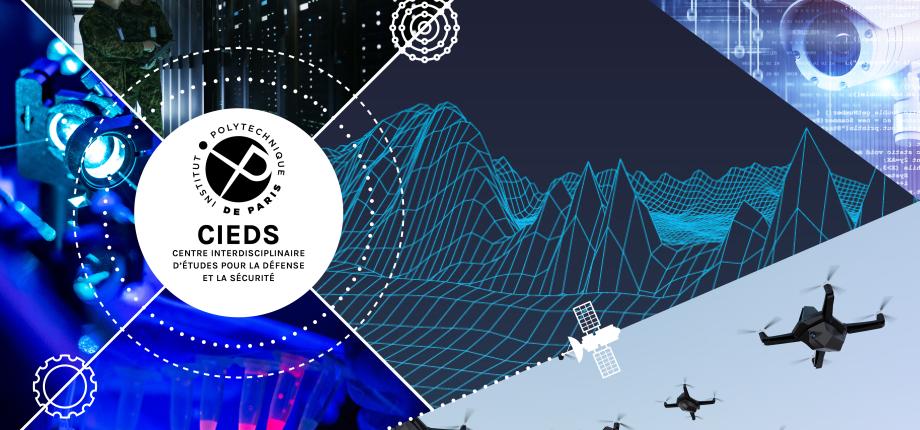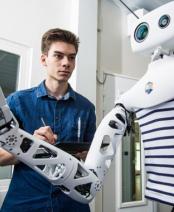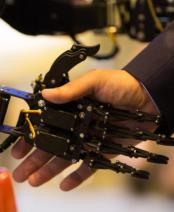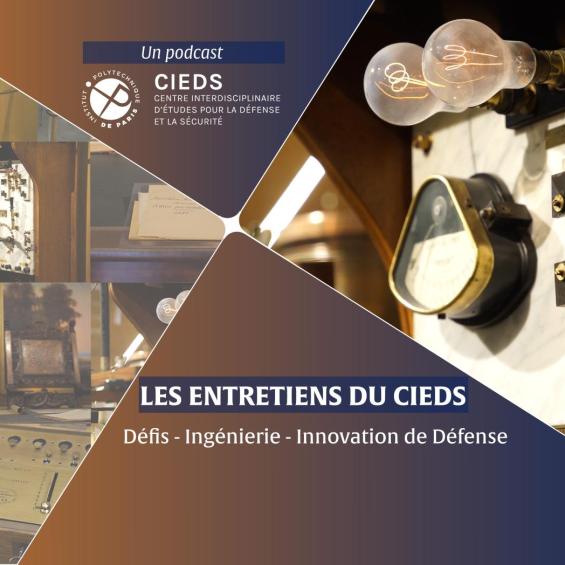CIEDS - Interdisciplinary Centre for Defence and Security

Key figures
25 IP Paris laboratories involved in Defence and Security.
120 permanent researchers and teacher-researchers. 40 doctoral theses in progress.

60 studies underway, including 36 major new projects launched since 2021 in the frame of the CIEDS.
CIEDS is supported by the Agence de l’Innovation de Défense.

The CIEDS addresses Research, Education, and Technology transfer:
- Conduct cutting-edge scientific research in areas of interest to defence.
- Target scientific and technological devices that are not accessible to our forces and promise high added value in operations.
- Capture these scientific and technological breakthroughs as soon as possible, ensure their scaling up, and transfer to the Defense Industrial and Technological Base or to deep-tech spin-offs.
- Implement or adapt the courses offered by IP Paris to better take into account the needs of Defence.
- Connect the communities of researchers, students, staff of the Ministère des armées, and partners - National Research Organisations, funding agencies, companies - around defence issues.
The CIEDS currently works on ten research areas:
- Cybersecurity and Digital Security: study of complex systems from a cybersecurity perspective, operations research methods for the design of optimal and robust networks, tactical discrete communications, joint modelling of security and cybersecurity...
- Robotics and Artificial Intelligence: study of model-driven and/or data-driven algorithms for the successful operation of swarm drones...
- Imaging and modelling for systems engineering: analysis of group behaviour by thermal cameras with uncertainty modelling, study of wave imaging methods in uncertain environments and passive communication, real-time inverse problem solving, noise modelling of turbulent flows applied to airfoils and jets, model reduction for thin finite element discretized structures...
- Energy optimisation and propulsion: modelling of thermal decomposition and combustion of energetic materials, production of hydrogen from food waste, reduced-order multi-scale modelling of two-phase flows with strong coupling between phases, wake control...
- Intense lasers and applications: Laser-Plasma technologies of X-ray sources for non-destructive testing, post-compression of laser pulses amplified by doped optical fibre beams...
- Quantum technologies: projects under construction
- Innovative materials and functionalization: dynamic behaviour of microarchitectured composites, development of aluminium matrix nano-composites for lightening, durability and wear resistance of structures, qualification of a multiphase metal alloy developed by additive manufacturing for use in severe environments, functional architectural materials obtained by micrometric 3D printing, etc.
- Detection of biological and chemical threats and care of the combatant: ultra-sensitive detection of viral nucleic acids of interest for defence, modelling and prediction of enzymatic mutations for the treatment of melioidosis, identification of airborne chemical agents by amplified raman spectroscopy, simulation by additive manufacturing of the face for maxillofacial surgery, treatment of infected wounds in burn victims by cold plasmas...
- Management of defence innovation: steering innovative defence projects, reinforcing the efficiency of complex programme management processes, while reconciling innovation and scientific knowledge production strategies; links between blockchain and artificial intelligence...
- Technological sovereignty and defence strategy: systemic analyses aimed at steering strategic innovation in a context of holistic conflicts and the emergence of new regional powers...
The CIEDS aims to reinforce partnerships and highlight its research results:
Promote interaction between laboratories, students and companies
- Opening a natural gateway to IP Paris for all the players in the Defence sector
- Running a permanent showroom of IP Paris innovations for Defence
- Organise cross-missions to discover IP Paris laboratories, sites of the Ministère des armées and industrial sites
- Organise student challenges with the support of industrials
Initiate collaborative projects
- Associate laboratories, start-ups/SMEs and DTIBs around disruptive technological projects
- Apply for national and European calls for projects, seed funds...
Scale-up and transfer emerging technologies
- Set up spaces dedicated to Proof Of Concept, places of experimentation open to users and reconfigurable according to the projects
- Lead a Club of industrial partners, providing privileged access to CIEDS' results and protected technologies
- Cooperate with SATT Paris-Saclay to mature CIEDS technologies to transfer and dual use
The CIEDS mobilises all the scientific strengths of IP Paris to support research projects of interest to Defence and Security. Our main ongoing projects:
Objectives:
- Understand the diffraction of waves in the vicinity of singular objects with edges or conical points.
- Develop passive imaging and communication methods, using ambient noise sources or opportunistic sources.
- Develop imaging algorithms in complex environments, with measurement uncertainties, uncertainties in the sources or in the propagation medium. Tevelop efficient inversion methods, suitable for large problems or for real-time imaging, which take into account the non-linearity of the problem.
Applications :
- Passive radar or sonar imaging with greater stealth Improved radar or sonar imaging performance
Objectives:
- Develop new perception and control algorithms for drone swarms in all types of environments (land, sea, air).
- Develop new validation methods to ensure the functioning of these algorithms, respecting real time constraints and operating domains. Implementing artificial intelligence techniques.
- Open an outdoor robotics platform and establish an experimental environment open to external users.
Applications :
- Progression of UAV swarms for defence or dual applications, such as search-and-rescue missions, building inspection, or area surveillance.
- Driver assistance systems in unstructured environments for piloted or remotely piloted vehicles.
Objectives:
- Build a demonstrator of digital attacks and defence mechanisms in the field of intelligent buildings, including many connected systems that are potential targets of attacks aimed at disrupting the functioning of the whole building.
- Specify the expected security properties by defining security policies that ensure full risk coverage. Deploy mechanisms to enforce these extended security policies.
- Verify the effectiveness of these mechanisms using a rigorous and reproducible methodology.
- Develop new tools to detect and respond to attacks on this type of equipment.
Applications :
- Protection of sensitive buildings against cyber attacks.
Objectives:
- To develop a detailed understanding of the combustion of energetic materials for Defence (explosives, propellants, gas generators) by implementing fundamental and applied know-how in combustion, thermochemistry, process thermodynamics, simulation and theoretical chemistry.
- Establish detailed and reduced thermo-kinetic models capable of predicting the combustion of energetic materials.
- Propose predictive tools enabling manufacturers to predict the sensitivity to impact, shock or friction of new materials implemented following the evolution of regulations.
Applications:
- Modifications of additives in energetic materials Defence, explosives or propellants, to meet REACH requirements.
Objectives:
- Develop intense X-ray sources using very high power lasers.
- Adapt the target to be compatible with an increased rate of laser fire.
- Develop the capabilities and performance of the SHERIL platform in terms of stability, resolution and signal-to-noise ratio.
- To model the complete chain for X-ray imaging: optimised physical model (digital twin) simulating the generation of the electron source, the conversion into X-rays, and then the interaction of the X-rays with the parts to be X-rayed.
Applications:
- Very high resolution (sub-millimetre) non-destructive testing of thick metal parts, including those produced by additive manufacturing.
Objectives:
- Identify areas of progress in the management of development and innovation processes, particularly within ecosystems that closely mix public and private sector actors, such as the armaments sector.
- Targeting areas for improvement in project management practices and processes.
Methodology:
- Interviews with contacts at Ministère des armées – AID and with industrial partners.
- Observation of existing processes, or retrospective analysis of past projects.
- Analyse practices, constraints and capacities for introducing innovations into programmes.
Applications:
- Acculturation on the key issues identified by the study.
- Proposal of systemic management tools (typologies, decision matrices, evaluation tools). Support for major industrial defence programmes
Objectives:
- Qualify a duplex steel fabricated by additive manufacturing for use under cyclic loading in a corrosive environment.
- Compare and hybridize two additive manufacturing processes, by powder bed or powder spraying. Optimise the microstructure of a two‐phase steel (ferrite and austenite) with or without thermal or thermomechanical post‐treatment.
- Characterise fatigue properties as a function of microstructure and analyse the role of corrosion in crack propagation.
- Study the competition between defects and microstructure in fatigue by a coupled experimental and numerical approach.
Applications :
- Adaptation or functionalisation of forged or additively manufactured parts.
- Preventive or corrective maintenance of parts used in a marine and/or corrosive environment.
Objectives:
- Develop an ultra‐sensitive method for the detection of RNA viruses causing hemorrhagic fevers, without amplification of the viral cDNA.
- Optimise the performance of nanoparticles used as virus detection probes.
- Miniaturise the hardware associated with this detection.
- Propose reagents ‐ nanoparticles coupled to specific oligonucleotides ‐ that are lyophilised and do not require freezing.
Applications :
- Highly sensitive detection of viral RNA/DNA for deployment in the field of operations.
Objectives:
- Build two video databases, the first in a living lab equipped with a thermal camera and motion sensors, the second in a city environment with thermal and colour information.
- To perform a greyscale analysis of thermal camera video scenes, by extracting 3D skeletons of individuals and semantic segmentation.
- Identify actions that involve individuals in the scene and study the interaction of groups.
- Model and estimate the uncertainty and validity range of the predictions made.
Applications :
- Analysis of scenes filmed by infrared cameras.
- Analysis of the behaviour of people in camouflage or loose clothing. Identification of individuals or groups exhibiting aggressive behaviour.
Objectives:
- Develop wireless network security through advanced statistical signal processing and digital communications algorithms to meet the field constraints of tactical communications.
- Test and make more robust direct sequence spread spectrum techniques under the most severe intentional interference conditions - hostile jamming -.
- Reduce synchronisation errors due to the Doppler effect when communicating entities are moving rapidly.
- Develop wireless network security through advanced statistical signal processing and digital communications algorithms to meet the field constraints of tactical communications.
- Test and make more robust direct sequence spread spectrum techniques under the most severe intentional interference conditions - hostile jamming -.
- Reduce synchronisation errors due to the Doppler effect when communicating entities are moving rapidly.
Applications:
- Secure tactical communications, discreet and resistant to interference
- Improved performance of civil telecom networks - local area networks, internet of things - in interference situations (jammers, multiple access)
Objectives:
- Anticipate the deployment of Blockchain technology to secure exchanges between state entities and private partners in the defence sector.
- Systematically analyse the emergence trajectories of blockchain technology from the European Patent Office databases and reports.
- Adapting the first cumulative structural models for the dissemination of Blockchain technology.
Applications :
- Improvement of the protection of data exchanged between socio‐economic partners in the defence sector. A tool for analysing the emergence and diffusion of the technologies of the 4th Industrial Revolution.
The CIEDS management team is composed of:
The CIEDS addresses Research, Education, and Technology transfer:
- Conduct cutting-edge scientific research in areas of interest to defence.
- Target scientific and technological devices that are not accessible to our forces and promise high added value in operations.
- Capture these scientific and technological breakthroughs as soon as possible, ensure their scaling up, and transfer to the Defense Industrial and Technological Base or to deep-tech spin-offs.
- Implement or adapt the courses offered by IP Paris to better take into account the needs of Defence.
- Connect the communities of researchers, students, staff of the Ministère des armées, and partners - National Research Organisations, funding agencies, companies - around defence issues.
The CIEDS currently works on ten research areas:
- Cybersecurity and Digital Security: study of complex systems from a cybersecurity perspective, operations research methods for the design of optimal and robust networks, tactical discrete communications, joint modelling of security and cybersecurity...
- Robotics and Artificial Intelligence: study of model-driven and/or data-driven algorithms for the successful operation of swarm drones...
- Imaging and modelling for systems engineering: analysis of group behaviour by thermal cameras with uncertainty modelling, study of wave imaging methods in uncertain environments and passive communication, real-time inverse problem solving, noise modelling of turbulent flows applied to airfoils and jets, model reduction for thin finite element discretized structures...
- Energy optimisation and propulsion: modelling of thermal decomposition and combustion of energetic materials, production of hydrogen from food waste, reduced-order multi-scale modelling of two-phase flows with strong coupling between phases, wake control...
- Intense lasers and applications: Laser-Plasma technologies of X-ray sources for non-destructive testing, post-compression of laser pulses amplified by doped optical fibre beams...
- Quantum technologies: projects under construction
- Innovative materials and functionalization: dynamic behaviour of microarchitectured composites, development of aluminium matrix nano-composites for lightening, durability and wear resistance of structures, qualification of a multiphase metal alloy developed by additive manufacturing for use in severe environments, functional architectural materials obtained by micrometric 3D printing, etc.
- Detection of biological and chemical threats and care of the combatant: ultra-sensitive detection of viral nucleic acids of interest for defence, modelling and prediction of enzymatic mutations for the treatment of melioidosis, identification of airborne chemical agents by amplified raman spectroscopy, simulation by additive manufacturing of the face for maxillofacial surgery, treatment of infected wounds in burn victims by cold plasmas...
- Management of defence innovation: steering innovative defence projects, reinforcing the efficiency of complex programme management processes, while reconciling innovation and scientific knowledge production strategies; links between blockchain and artificial intelligence...
- Technological sovereignty and defence strategy: systemic analyses aimed at steering strategic innovation in a context of holistic conflicts and the emergence of new regional powers...
The CIEDS aims to reinforce partnerships and highlight its research results:
Promote interaction between laboratories, students and companies
- Opening a natural gateway to IP Paris for all the players in the Defence sector
- Running a permanent showroom of IP Paris innovations for Defence
- Organise cross-missions to discover IP Paris laboratories, sites of the Ministère des armées and industrial sites
- Organise student challenges with the support of industrials
Initiate collaborative projects
- Associate laboratories, start-ups/SMEs and DTIBs around disruptive technological projects
- Apply for national and European calls for projects, seed funds...
Scale-up and transfer emerging technologies
- Set up spaces dedicated to Proof Of Concept, places of experimentation open to users and reconfigurable according to the projects
- Lead a Club of industrial partners, providing privileged access to CIEDS' results and protected technologies
- Cooperate with SATT Paris-Saclay to mature CIEDS technologies to transfer and dual use
The CIEDS mobilises all the scientific strengths of IP Paris to support research projects of interest to Defence and Security. Our main ongoing projects:
Objectives:
- Understand the diffraction of waves in the vicinity of singular objects with edges or conical points.
- Develop passive imaging and communication methods, using ambient noise sources or opportunistic sources.
- Develop imaging algorithms in complex environments, with measurement uncertainties, uncertainties in the sources or in the propagation medium. Tevelop efficient inversion methods, suitable for large problems or for real-time imaging, which take into account the non-linearity of the problem.
Applications :
- Passive radar or sonar imaging with greater stealth Improved radar or sonar imaging performance
Objectives:
- Develop new perception and control algorithms for drone swarms in all types of environments (land, sea, air).
- Develop new validation methods to ensure the functioning of these algorithms, respecting real time constraints and operating domains. Implementing artificial intelligence techniques.
- Open an outdoor robotics platform and establish an experimental environment open to external users.
Applications :
- Progression of UAV swarms for defence or dual applications, such as search-and-rescue missions, building inspection, or area surveillance.
- Driver assistance systems in unstructured environments for piloted or remotely piloted vehicles.
Objectives:
- Build a demonstrator of digital attacks and defence mechanisms in the field of intelligent buildings, including many connected systems that are potential targets of attacks aimed at disrupting the functioning of the whole building.
- Specify the expected security properties by defining security policies that ensure full risk coverage. Deploy mechanisms to enforce these extended security policies.
- Verify the effectiveness of these mechanisms using a rigorous and reproducible methodology.
- Develop new tools to detect and respond to attacks on this type of equipment.
Applications :
- Protection of sensitive buildings against cyber attacks.
Objectives:
- To develop a detailed understanding of the combustion of energetic materials for Defence (explosives, propellants, gas generators) by implementing fundamental and applied know-how in combustion, thermochemistry, process thermodynamics, simulation and theoretical chemistry.
- Establish detailed and reduced thermo-kinetic models capable of predicting the combustion of energetic materials.
- Propose predictive tools enabling manufacturers to predict the sensitivity to impact, shock or friction of new materials implemented following the evolution of regulations.
Applications:
- Modifications of additives in energetic materials Defence, explosives or propellants, to meet REACH requirements.
Objectives:
- Develop intense X-ray sources using very high power lasers.
- Adapt the target to be compatible with an increased rate of laser fire.
- Develop the capabilities and performance of the SHERIL platform in terms of stability, resolution and signal-to-noise ratio.
- To model the complete chain for X-ray imaging: optimised physical model (digital twin) simulating the generation of the electron source, the conversion into X-rays, and then the interaction of the X-rays with the parts to be X-rayed.
Applications:
- Very high resolution (sub-millimetre) non-destructive testing of thick metal parts, including those produced by additive manufacturing.
Objectives:
- Identify areas of progress in the management of development and innovation processes, particularly within ecosystems that closely mix public and private sector actors, such as the armaments sector.
- Targeting areas for improvement in project management practices and processes.
Methodology:
- Interviews with contacts at Ministère des armées – AID and with industrial partners.
- Observation of existing processes, or retrospective analysis of past projects.
- Analyse practices, constraints and capacities for introducing innovations into programmes.
Applications:
- Acculturation on the key issues identified by the study.
- Proposal of systemic management tools (typologies, decision matrices, evaluation tools). Support for major industrial defence programmes
Objectives:
- Qualify a duplex steel fabricated by additive manufacturing for use under cyclic loading in a corrosive environment.
- Compare and hybridize two additive manufacturing processes, by powder bed or powder spraying. Optimise the microstructure of a two‐phase steel (ferrite and austenite) with or without thermal or thermomechanical post‐treatment.
- Characterise fatigue properties as a function of microstructure and analyse the role of corrosion in crack propagation.
- Study the competition between defects and microstructure in fatigue by a coupled experimental and numerical approach.
Applications :
- Adaptation or functionalisation of forged or additively manufactured parts.
- Preventive or corrective maintenance of parts used in a marine and/or corrosive environment.
Objectives:
- Develop an ultra‐sensitive method for the detection of RNA viruses causing hemorrhagic fevers, without amplification of the viral cDNA.
- Optimise the performance of nanoparticles used as virus detection probes.
- Miniaturise the hardware associated with this detection.
- Propose reagents ‐ nanoparticles coupled to specific oligonucleotides ‐ that are lyophilised and do not require freezing.
Applications :
- Highly sensitive detection of viral RNA/DNA for deployment in the field of operations.
Objectives:
- Build two video databases, the first in a living lab equipped with a thermal camera and motion sensors, the second in a city environment with thermal and colour information.
- To perform a greyscale analysis of thermal camera video scenes, by extracting 3D skeletons of individuals and semantic segmentation.
- Identify actions that involve individuals in the scene and study the interaction of groups.
- Model and estimate the uncertainty and validity range of the predictions made.
Applications :
- Analysis of scenes filmed by infrared cameras.
- Analysis of the behaviour of people in camouflage or loose clothing. Identification of individuals or groups exhibiting aggressive behaviour.
Objectives:
- Develop wireless network security through advanced statistical signal processing and digital communications algorithms to meet the field constraints of tactical communications.
- Test and make more robust direct sequence spread spectrum techniques under the most severe intentional interference conditions - hostile jamming -.
- Reduce synchronisation errors due to the Doppler effect when communicating entities are moving rapidly.
- Develop wireless network security through advanced statistical signal processing and digital communications algorithms to meet the field constraints of tactical communications.
- Test and make more robust direct sequence spread spectrum techniques under the most severe intentional interference conditions - hostile jamming -.
- Reduce synchronisation errors due to the Doppler effect when communicating entities are moving rapidly.
Applications:
- Secure tactical communications, discreet and resistant to interference
- Improved performance of civil telecom networks - local area networks, internet of things - in interference situations (jammers, multiple access)
Objectives:
- Anticipate the deployment of Blockchain technology to secure exchanges between state entities and private partners in the defence sector.
- Systematically analyse the emergence trajectories of blockchain technology from the European Patent Office databases and reports.
- Adapting the first cumulative structural models for the dissemination of Blockchain technology.
Applications :
- Improvement of the protection of data exchanged between socio‐economic partners in the defence sector. A tool for analysing the emergence and diffusion of the technologies of the 4th Industrial Revolution.
















